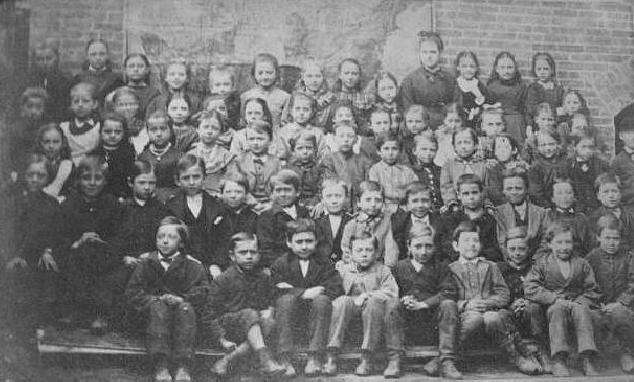
U.S. School Clothes: Individual Schools--The 1860s

Figure 1.-- This CDV school portrait is unidentified. We do not know the name of the school or where it was located. It is alo undated, but we believe it was taken in the late-1860s. The early 70s is possible, but the late-60s is more likely. The wall map of the United States in the background is especilly useful in dateing the image.
|
|
School portraits were not really feasible until the 1860s. Once photographic processes creating negatives were developed, a whole new economic activity fr phothraphers opened up--school portraits. One portrait could be taken for sale to all interested parents. We do not, however, notice many school portraits from the 1860s. We have found many individual portraits of children, but school group portraits are realativeky rare. Younger boys had begun wearing knee pants suits in the 1860s, but this seems to have been mostly boys from fashionable big-city families. The few 1860s images we have found mostly show the boys wearing long pants.
We are not sure about the name of the school here. We presume that it was the Visalia School as it was located in Visalia, California. Most early schools like this were simply named after the name of the town where they were located. It looks like an early public school. It is dated 1860, but we would take this as more of an assessment than a precise date. We might gues it was taken a little later, but the 1860s is a distinct possibility. Almost all the boys wear long pants. Only one boy wears kneepants. Several boys look to be wearing dresses, but we suspect that these may be girls with short hair cuts.
This is a Civil War era salt print of a large group of school children with their young lady teacher. This portrait was taken in the 1860s, but we do not knpw the exact date. Nor do we know where it was taken. One interesting note: The face of Edwin Christian, standing in the center above the teacher, has been superimposed over the original photograph. We have know idea why. Perhaps he moved during the exposure spoiling his image. (Exposures in the 1860s were still rather long.) His sister Anna Christian is standing to his left. Anna Christian's right hand is resting on the teacher's left shoulder. The two siblings are identified by the caption under the photo "Ed Christian in center. Anna Christian to the left of Ed Christian." Most of the boys wear long pants suits, most sack suit jackets with lapels. Two of the younger boys wear cut-away jackets and the youngest wear tinic suit, one boy with bloomer knickers.
This is a rare photograph of 1860s school class. School photography was onlky beginning at the time. It is a 1/2 plate (5.5" x 4.5" cased tin type. Most tintypes were not cased, but in the early-1860s some were because the convention of casing Dags and Ambros was so strong. A tin type meant that only one copy was avaialble. This is why almost all school portraits were albumen prints so copies could be made for the parents who wanted them to send to family and friends. Probably it was made for the teacher. Unlike most cased portrits, there is some information about this portrait. The teachrr is identified in the case as Victoria Cheek. The school was located at Burkesville Kentucky. This portrit had to be taken during or just after the Civil War, as Miss Cheek was married in 1866. Her new name was Rand. The boys wear a variety of suit jackets with long oants. Stangrlu, two children at vthe center look likev boys wearing smocks over askorted hrment. We don't know what to make of that. One of the boys looks very young, the other who may be his brother is several years older.
Unidentified School (late 1860s)
This CDV school portrait is unidentified (figure 1). We do not know the name of the school or where it was located. It is alo undated, but we believe it was taken in the late-1860s. The early 70s is possible, but the late-60s is more likely. The wall map of the United States in the background is especilly useful in dateing the image. It depicts the boundaries of Arizona as they were from 1864, but before 1867. This is known because Arizona has boundaries that are separate from New Mexico and the southern tip of Nevada is still part of Arizona, which changed in May 1866. The CDV is consistent with the 1860s as is the clothes the boys are wearing. Note that even though these are younger boys, all but one boy wears long pants.
HBC-SU

Related Chronolgy Pages in the Boys' Historical Web Site
[Main Chronology Page]
[The 1800s]
[The 1810s]
[The 1820s]
[The 1830s]
[The 1840s]
[The 1850s]
[The 1860s]
[The 1870s]
[The 1880s]
[The 1890s]
[The 1900s]
Navigate the Relate Boys Historical Clothing Style Pages
[Main country page]
[Long pants suits]
[Short pants suits]
[Lederhosen]
[Kneesocks]
[Eton suits]
[Jacket and trousers]
[Blazer
[School sandals]
[Bloomers]
[Rompers]
Navigate the Boys' Historical Clothing School Uniform Pages
[Main National School Uniform Page]
[Australia]
[England]
[France]
[Germany]
[Ireland]
[Italy]
[Japan]
[New Zealand]
[Poland]
[Singapore]
[Scotland]
[Singapore]
[United Stsates]
Navigate the Boys' Historical Clothing Web Page
[Return to the Main American 19th century school page]
[Introduction]
[Activities]
[Biographies]
[Chronology]
[Cloth and textiles]
[Clothing styles]
[Countries]
[Girls]
[Topics]
[Bibliographies]
[Contributions]
[FAQs]
[Glossaries]
[Images]
[Registration]
[Tools]
[Boys' Clothing Home]
Created: 8:27 PM 1/9/2009
Last updated: 8:27 PM 1/9/2009




